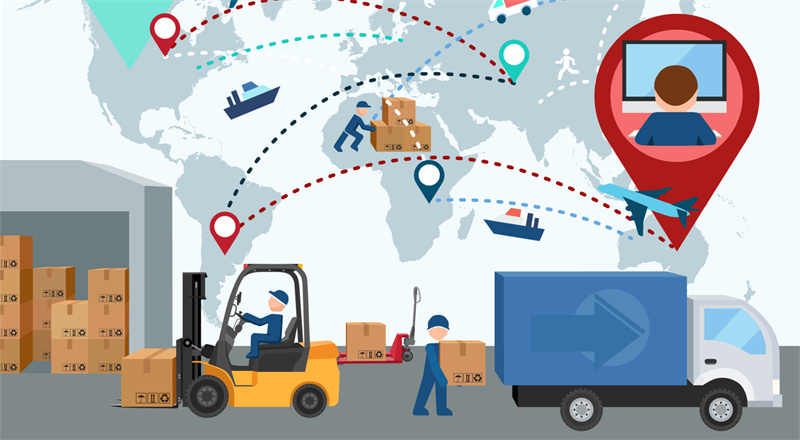In the ever-evolving landscape of modern commerce, the optimization of logistics and transportation stands as a pivotal cornerstone for sustained success. At the forefront of this operational paradigm is the Transportation Management System – an intricate software solution meticulously designed to streamline shipping processes and fortify the logistical backbone of your enterprise.
Understanding the Transportation Management System

A TMS serves as a specialized subset within the expansive realm of supply chain management, laser-focused on orchestrating the precise movement of goods. This pivotal system seamlessly integrates within the broader framework of enterprise resource planning (ERP), aligning transportation intricately with core business processes to ensure seamless functionality and efficiency.
At its core, a TMS technology optimizes time, drivers, and resources when moving goods. This real-time asset tracking solution is instrumental in ensuring compliance with legal regulations and handling administrative tasks effectively.
One of the key functionalities of a TMS is its data collection capability. By collecting and analyzing data, a TMS empowers businesses to automate and enhance various processes. This data is consolidated into a dashboard, providing easy access for informed decision-making and process improvement.
TMS Licensing
When delving into Transportation Management System implementation, businesses encounter a range of licensing options tailored to accommodate varying operational demands:
- On-Premises Licensing: This involves installing and accessing the system locally through the company’s server or device.
- Hosted Licensing: Users rent the software from a vendor or provider rather than owning it outright.
- On-Premises Hosted Licensing: A blend of both on-premises and hosted approaches, offering flexibility in implementation.
- Hosted TMS Free of Licensing: Similar to a hosted solution but without the need for any licenses, simplifying the setup process.
Choosing the appropriate licensing type depends on the unique needs and preferences of each business. Providers typically offer these options, allowing users to select the most suitable arrangement for seamless integration into their operations.
Unveiling the Key Functions & Benefits of TMS
Delving into the intricate web of Transportation Management Systems unfolds a spectrum of indispensable functionalities and advantages crucial for navigating today’s complex logistics landscape.
Core Functionalities
- Administrative Efficiency: Managing documentation, billing, payment processing, and invoice tracking.
- Supply Chain Optimization: Enhancing efficiency, reducing warehousing costs, and improving customer service through streamlined operations.
- Load Planning: Strategically combining freight for cost-effective and quality-driven deliveries.
Operational Advantages
- Route Optimization: Executing transportation plans, managing carrier interactions, and facilitating electronic data interchange (EDI).
- Business Intelligence & Reporting: Interactive dashboards offering shipping insights for informed decision-making.
- Logistics KPI Measurement: Tracking transportation, delivery times, accuracy, and other crucial metrics.
Enhanced Capabilities
- Transport Follow-Up: Overseeing administrative and physical operations associated with transportation, ensuring seamless processes.
- Fleet Management: Real-time visibility into vehicle routes, optimizing fleet activities for efficient order handling.
- Real-time Tracking & Tracing: Elevating customer satisfaction through shipment visibility from pickup to delivery.
Crafting the Ideal TMS for Your Business

In the realm of optimizing Transportation Management Systems, Euristiq emerges as a trailblazer in software engineering and consulting services, adept at shepherding businesses through transformative digital journeys. The craft of tailoring a Management System is a strategic endeavor, one that Euristiq recommends navigating with a meticulous approach:
1. Goal Definition
Begin by articulating precise targets and objectives that will serve as the guiding stars steering the system’s functionalities in perfect alignment with the overarching business objectives. This foundational step ensures that every facet of the TMS resonates with your enterprise’s strategic direction.
2. Feature Selection
Carefully curate TMS attributes that precisely align with the unique needs and operational intricacies of your enterprise. This process involves a thoughtful selection process, ensuring that the chosen features seamlessly integrate into your existing infrastructure, enhancing operational relevance without disruption.
3. Budget Realism
Accurate cost estimation is paramount. It prevents the compromise of system quality or scope, ensuring that the envisioned TMS remains robust and effective. Balancing ambitions with budgetary constraints is crucial to the success of the implementation.
4. User Engagement
Solicit invaluable insights from end-users and customers. Their input is pivotal in refining choices and ensuring a user-centric design. By incorporating user feedback into the system’s blueprint, you guarantee usability and efficacy, ultimately driving higher adoption rates.
5. Development Evaluation
A comprehensive evaluation phase is essential. It involves scrutinizing the scope, intricacies, and potential constraints of TMS development. This assessment lays the groundwork for a well-devised, holistic plan that mitigates risks and maximizes efficiency.
6. Idea Validation
Conduct exhaustive market research and contemplate the possibility of an MVP version. This approach effectively validates concepts and gauges market readiness before full-scale implementation. It’s a strategic move to ensure that your TMS aligns precisely with market needs and expectations.
Transportation Management System serves as strategic assets, not merely software solutions. They empower organizations to streamline operations, enhance efficiency, and gain a competitive edge in today’s dynamic business landscape. Understanding their functionalities, aligning them with business needs, and implementing a well-designed TMS ensures optimal results in the realm of logistics and supply chain management.
